Every December, we look at some aspect of the vast array of holiday coffees on offer from roasters around the world. This year, we focus on blends — specifically, holiday-themed blends, as interpreted by roasters and available only during the holiday season (roughly November to February). Creating exciting holiday blends has become something of a year-end competition among good specialty roasters over the last few years. Gone are the days when a holiday blend was simply a way to sell aging green coffees left in the warehouse from earlier in the year, wrapped up in festive packaging and marketed as something special. And when you think about it, it may be more difficult to craft a fine blend than it is to nail the roast profile of a green coffee that’s already exceptional. Developing an original blend requires an open mind and full sensory attention, because the goal is to create an entirely new coffee experience.
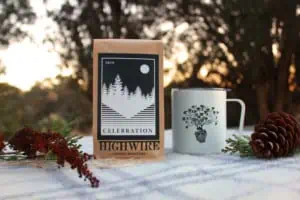
Highwire Coffee Roasters’ Celebration Blend. Courtesy of Highwire Coffee.
The Scorecard
Of the 56 coffees we received to consider for this report — roasted in the U.S., Canada, Mexico, Hong Kong, Taiwan, and Thailand — nine rose to the top with scores ranging from 91 to 94. There were quite a few 90s as well, too many of them to review here (14, to be exact, which means that a full 23 coffees rated 90 or higher, nearly half of all the submissions we received.)
Benchmarking with National Brands
Starting with this tasting report, and moving forward into 2020, we plan to include, when possible, reviews of what we are calling “benchmark samples,” i.e., samples of coffees of similar origin or style to those submitted by roasters for a given report. We will purchase these coffees anonymously from national (or large regional) brands. The idea is to give readers an idea of how the best of the coffees we review in any given month (usually current offerings from smaller regional roasting companies) stack up when compared to samples of similar, more widely distributed coffees from larger brands. This month, for example, we bought holiday blends from Starbucks and Peet’s Coffee as our benchmarks. (See below for more on that.)
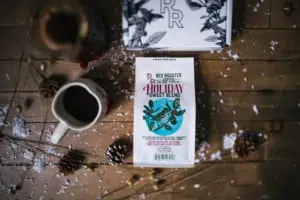
Red Rooster Coffee Roasters’ Holiday Sweet Blend. Courtesy of Tony Greatorex.
The Influence of Natural-Processed Coffees
If there is a theme in this report beyond the skill of the roasters who crafted these compelling blends, it’s their imaginative use of natural-process coffees, or coffees that were dried in the whole fruit, rather than after removal of the soft fruit residue, as is the case with more conventional wet-process or washed coffees. In seven of the 10 blends we review here the more fruit-forward profiles of the natural-process coffees are played against the usually lighter, brighter profiles of washed-process beans, with distinctive and intriguing results.
Hong Kong’s Plat Coffee Roastery submitted a Holiday Blend that tied for the top score at 94, comprised of a washed-process and a natural-process coffee, both from Ethiopia — resulting in a cleanly fruit-toned cup with notes of strawberry, sandalwood and lemon verbena.

Sample roast testing at Plat Coffee Roastery in Hong Kong. Courtesy of Plat Coffee.
Red Rooster Coffee Roaster’s Holiday Sweet blend is no stranger to our annual holiday report; this year’s version scored 93. Head roaster Tony Greatorex says, “My goal each year with the Holiday Sweet is to find the sweetest combination of coffees possible. I’m also looking to create a blend that is so seamless in flavor that it could be mistaken for a single-origin. Historically, it has been heavy on high-toned natural and washed Ethiopias, and this year is no different. In the last two years, I’ve rounded out the profile with clean, sweet, and balanced washed Colombias, due to an abundance of high quality coffees coming from that country.”
Lucky Cafe’s Holiday Blend, also at 93, is comprised of two Ethiopias, a natural and a washed, and a washed Kenya. The Kenya (red currant, cocoa nib) grounds the blend, while the natural Ethiopia (blackberry) gives it fruity levity.
Coming in at 92 is Canadian roaster Detour’s Holiday Blend, combining an Ethiopia Guji natural-process, a Costa Rica Tarrazu white honey-process, and a Kenya Nyeri washed. Head roaster Dan Sherrington says he was going for “a dynamic, approachable and balanced cup, a real crowd-pleaser.” Specifically thinking of the holiday season, he says, “We think some combination of fruit, chocolate, spice and sugary sweetness creates a really nice flavor profile, basically a dessert-like coffee.”
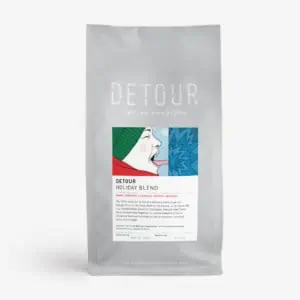
Detour Coffee’s Holiday Blend. Courtesy of Detour Coffee.
Similar in style is Temple Coffee’s Festivity Blend, a fruit- and nut-driven coffee that represents collaboration between Camilla Yuan (head roaster) and Ed Whitman (director of coffee). After several rounds of failed prototype blends, Yuan and Whitman created their own blends separately and cupped them blind. Whitman says, “It was unanimous. Camilla’s blend leaped off the table for its fruit-forward complexity.” The Open Seas Wonderland Blend (91) is made up of a washed Nicaragua and a natural-process Ethiopia Sidama, which, according to owner-head roaster Bryce Roszell combines two great single-origins that, together, take us to a new place that neither origin could do alone. He says, “I find that memory and nostalgia is so directly invoked by food and drink, and when I taste this coffee, it takes me back to my mom baking gingerbread cookies and Herb Alpert’s Christmas Album playing in the background. In Wonderland, I want to connect people to this blend of warmth and excitement that the holidays bring through the types of notes that can resonate on a deeper nostalgic level, as well.”
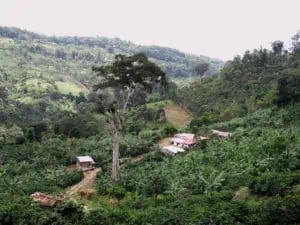
Don Francisco Farm in Nicaragua, where one of the blend components for Open Seas Wonderland Blend was produced. Courtesy of Benjamin Weiner.
Rounding out blends built around a combination of natural and washed-process coffees is Modern Times’ Invincible Sun God (92), perhaps the most original of the blends reviewed here and intended for both brewed and espresso applications. It starts with two natural-process coffees, an Ethiopia and a Brazil (which also constitute the base for Modern Times’ Guardian Spirit Espresso Blend), then adds a traditionally washed-process Kenya. Lily Quiros, head roaster, says, “The pomegranate/cranberry/red wine elements of the Kenya adds a holiday fruit aroma and warming flavor profile that our normal espresso blend does not have and plays well as an espresso or a pour over.” This coffee should appeal to those who like restrained, nicely nuanced darker roasts.
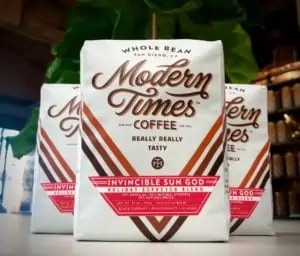
Invisible Sun God, one of Modern Times’ holiday coffees. Courtesy of Modern Times.
One Washed-Process and an All-Peru Blend
Tied for the top score at 94 is the Highwire Celebration Blend, selected by Eric Hashimoto to complement “colder weather and rich meals.” The artwork on the bag (by Katie Miller) evokes a classic woodcut with a peaceful winter scene, and the coffee inside is chocolaty and floral-toned. Founder Rich Avella says, “It shouldn’t taste like any other coffee,” and it doesn’t. It’s quite distinctive and worthy of any stocking this year.
Kickapoo’s entry, the Winter Solstice Blend (92), is a blend of coffees from three different growing areas of Peru, all processed by the washed method, but using a “dry” ferment (no water added to the tank), that nets a crisply sweet, rich-toned cup.
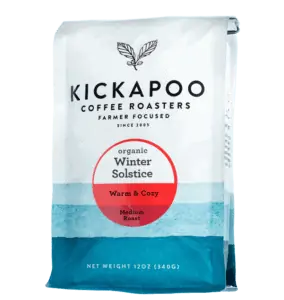
Kickapoo Coffee’s Winter Solstice Blend. Courtesy of Kickapoo Coffee.
A Successful Dark-Roasted Benchmark Coffee
We taste Peet’s coffees periodically, and this year’s Peet’s Dark Roast Holiday Blend we review in conjunction with this report as our benchmark coffee, at a solid score of 86. It’s a blend of wet-hulled Sumatra Lintong and washed-process Panama Finca Don Bosco. It’s quite dark-roasted, but maintains the character of the green coffees while giving lovers of dark roasts the big, chocolaty, smoky profile many find appealing.
And a Little Scrooge to Keep Things Real
The other benchmark coffee we tested was the Starbucks Christmas Blend, described on the brand’s website as comprised of “Latin American and mellow Indonesian” coffees. It’s essentially Starbucks’ version of a non-vintage wine, intended to taste as similar as possible year in and year out. There’s nothing wrong with that; some people like consistency. Since 2015, Starbucks has added to the mix a “rare, aged Sumatra coffee.” Though Starbucks’ website doesn’t elaborate, Sumatra coffees intended for aging are typically held in special warehouses, usually in Singapore, for two or more years, with the bags regularly rotated to even out moisture. This rather expensive process reduces acidity, modestly fattens body and contributes a musty character that can take on a variety of sensory guises, from spicy to cedary, smoky to chocolaty, grapefruity to plain musty. However, the likely small amount of aged Sumatra that made it into this year’s Starbucks Christmas Blend can’t do much to lift the blend’s disappointing character, which appears to be driven mainly by an aggressive dark roast — considerably darker than the Peet’s blend we review this month. Three of our main descriptors were rubbery cocoa, soapy florals and petrol.
We hope that benchmarking will make our reports more useful by providing points of reference for the coffees we’re recommending. And benchmarking is good for us here at Coffee Review, too, because it presses us to constantly examine our own biases and assumptions. This month, we discovered one coffee (the Peet’s) that we can recommend to lovers of dark roasts and another that we can steer you away from with confidence — not to mention nine coffees that you should run out and buy right now, all successful examples of the difficult art of blending.
Happy coffee drinking this holiday season!










